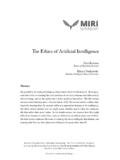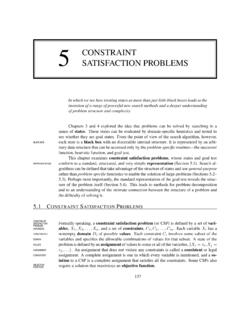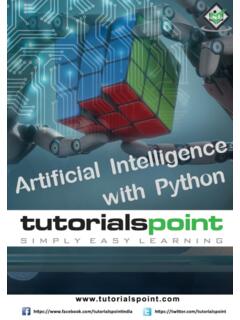Transcription of The Ethics of Artificial Intelligence
1 MIRIM ACHINE INTELLIGENCERESEARCH INSTITUTEThe Ethics of Artificial IntelligenceNick BostromFuture of Humanity InstituteEliezer YudkowskyMachine Intelligence Research InstituteAbstractThe possibility of creating thinking machines raises a host of ethical issues. These ques-tions relate both to ensuring that such machines do not harm humans and other morallyrelevant beings, and to the moral status of the machines themselves. The first sectiondiscusses issues that may arise in the near future of AI. The second section outlines chal-lenges for ensuring that AI operates safely as it approaches humans in its third section outlines how we might assess whether, and in what circumstances,AIs themselves have moral status. In the fourth section, we consider how AIs mightdiffer from humans in certain basic respects relevant to our ethical assessment of final section addresses the issues of creating AIs more intelligent than human, andensuring that they use their advanced Intelligence for good rather than , Nick, and Eliezer Yudkowsky.
2 Forthcoming. The Ethics of Artificial Intelligence . InCambridge Handbook of Artificial Intelligence , edited by Keith Frankish and William York: Cambridge University version contains minor Bostrom, Eliezer in Machine Learning and Other Domain-Specific AIAlgorithmsImagine, in the near future, a bank using a machine learning algorithm to recommendmortgage applications for approval. A rejected applicant brings a lawsuit against thebank, alleging that the algorithm is discriminating racially against mortgage bank replies that this is impossible, since the algorithm is deliberately blinded to therace of the applicants. Indeed, that was part of the bank s rationale for implementingthe system. Even so, statistics show that the bank s approval rate for black applicants hasbeen steadily dropping. Submitting ten apparently equally qualified genuine applicants(as determined by a separate panel of human judges) shows that the algorithm acceptswhite applicants and rejects black applicants.
3 What could possibly be happening?Finding an answer may not be easy. If the machine learning algorithm is based ona complicated neural network, or a genetic algorithm produced by directed evolution,then it may prove nearly impossible to understand why, or even how, the algorithm isjudging applicants based on their race. On the other hand, a machine learner based ondecision trees or Bayesian networks is much more transparent to programmer inspection(Hastie, Tibshirani, and Friedman 2001), which may enable an auditor to discover thatthe AI algorithm uses the address information of applicants who were born or previouslyresided in predominantly poverty-stricken algorithms play an increasingly large role in modern society, though usually notlabeled AI. The scenario described above might be transpiring even as we write. Itwill become increasingly important to develop AI algorithms that are not just powerfuland scalable, but alsotransparent to inspection to name one of many socially challenges of machine Ethics are much like many other challenges involved indesigning machines.
4 Designing a robot arm to avoid crushing stray humans is no moremorally fraught than designing a flame-retardant sofa. It involves new programmingchallenges, but no new ethical challenges. But when AI algorithms take on cognitivework with social dimensions-cognitive tasks previously performed by humans the AIalgorithm inherits the social requirements. It would surely be frustrating to find that nobank in the world will approve your seemingly excellent loan application, and nobodyknows why, and nobody can find out even in principle. (Maybe you have a first namestrongly associated with deadbeats? Who knows?)Transparency is not the only desirable feature of AI. It is also important that AIalgorithms taking over social functions bepredictable to those they govern. To understandthe importance of such predictability, consider an analogy. The legal principle ofstaredecisisbinds judges to follow past precedent whenever possible.
5 To an engineer, this1 The Ethics of Artificial Intelligencepreference for precedent may seem incomprehensible why bind the future to the past,when technology is always improving? But one of the most important functions of thelegal system is to be predictable, so that, , contracts can be written knowing howthey will be executed. The job of the legal system is not necessarily to optimize society,but to provide a predictable environment within which citizens can optimize their will also become increasingly important that AI algorithms berobust against ma-nipulation. A machine vision system to scan airline luggage for bombs must be robustagainst human adversaries deliberately searching for exploitable flaws in the algorithm for example, a shape that, placed next to a pistol in one s luggage, would neutralizerecognition of it. Robustness against manipulation is an ordinary criterion in informa-tion security; nearlythecriterion.
6 But it is not a criterion that appears often in machinelearning journals, which are currently more interested in, , how an algorithm scalesup on larger parallel important social criterion for dealing with organizations is being able tofind the person responsible for getting something done. When an AI system fails atits assigned task, who takes the blame? The programmers? The end-users? Modernbureaucrats often take refuge in established procedures that distribute responsibility sowidely that no one person can be identified to blame for the catastrophes that result(Howard 1994). The provably disinterested judgment of an expert system could turnout to be an even better refuge. Even if an AI system is designed with a user override,one must consider the career incentive of a bureaucrat who will be personally blamed ifthe override goes wrong, and who would much prefer to blame the AI for any difficultdecision with a negative , transparency, auditability, incorruptibility, predictability, and a ten-dency to not make innocent victims scream with helpless frustration: all criteria thatapply to humans performing social functions; all criteria that must be considered in analgorithm intended to replace human judgment of social functions; all criteria that maynot appear in a journal of machine learning considering how an algorithm scales up tomore computers.
7 This list of criteria is by no means exhaustive, but it serves as a smallsample of what an increasingly computerized society should be thinking General IntelligenceThere is nearly universal agreement among modern AI professionals that Artificial In-telligence falls short of human capabilities in some critical sense, even though AI algo-rithms have beaten humans in many specific domains such as chess. It has been sug-gested by some that as soon as AI researchers figure out how to do something, that2 Nick Bostrom, Eliezer Yudkowskycapability ceases to be regarded as intelligent chess was considered the epitome of in-telligence until Deep Blue won the world championship from Kasparov but even theseresearchers agree that something important is missing from modern AIs ( , Hofs-tadter 2006).While this subfield of Artificial Intelligence is only just coalescing, Artificial Gen-eral Intelligence (hereafter, AGI) is the emerging term of art used to denote real AI (see, , the edited volume Goertzel and Pennachin [2007]).
8 As the name im-plies, the emerging consensus is that the missing characteristic is generality. CurrentAI algorithms with human-equivalent or superior performance are characterized by adeliberately programmed competence only in a single, restricted domain. Deep Bluebecame the world champion at chess, but it cannot even play checkers, let alone drivea car or make a scientific discovery. Such modern AI algorithms resemble all biologi-cal life with the sole exception ofHomo sapiens. A bee exhibits competence at buildinghives; a beaver exhibits competence at building dams; but a bee doesn t build dams, anda beaver can t learn to build a hive. A human, watching, can learn to do both; but this isa unique ability among biological lifeforms. It is debatable whether human intelligenceis trulygeneral we are certainly better at some cognitive tasks than others (Hirschfeldand Gelman 1994) but human Intelligence is surelysignificantly more generally appli-cablethan nonhominid is relatively easy to envisage the sort of safety issues that may result from AI operat-ing only within a specific domain.
9 It is a qualitatively different class of problem to handlean AGI operating across many novel contexts that cannot be predicted in human engineers build a nuclear reactor, they envision the specific events thatcould go on inside it valves failing, computers failing, cores increasing in temperature and engineer the reactor to render these events noncatastrophic. Or, on a more mundanelevel, building a toaster involves envisioning bread and envisioning the reaction of thebread to the toasters heating element. The toaster itself does not know that its purposeis to make toast thepurposeof the toaster is represented within the designer s mind,but is not explicitly represented in computations inside the toaster and so if you placecloth inside a toaster, it may catch fire, as the design executes in an unenvisioned contextwith an unenvisioned side task-specific AI algorithms throw us outside the toaster-paradigm, the domainof locally preprogrammed, specifically envisioned behavior.
10 Consider Deep Blue, thechess algorithm that beat Garry Kasparov for the world championship of chess. Wereit the case that machines can only do exactly as they are told, the programmers wouldhave had to manually preprogram a database containing moves for every possible chessposition that Deep Blue could encounter. But this was not an option for Deep Blue sprogrammers. First, the space of possible chess positions is unmanageably large. Sec-3 The Ethics of Artificial Intelligenceond, if the programmers had manually input whattheyconsidered a good move in eachpossible situation, the resulting system would not have been able to make stronger chessmoves than its creators. Since the programmers themselves were not world champions,such a system would not have been able to defeat Garry creating a superhuman chess player, the human programmers necessarily sacri-ficed their ability to predict Deep Blue slocal, specificgame behavior.







